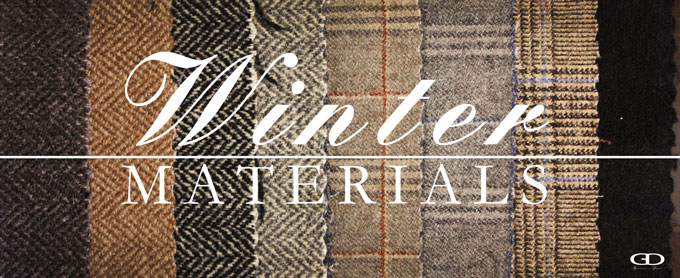
The days are getting shorter and the temperatures drop to levels where gentlemen are inclined to almost entirely sacrifice form for more function: little consideration is given to attire as long as it keeps us warm and well protected against the influences of wind, rain, and snow. Just like with summer wear, winter offers unique opportunities to upgrade a gentleman’s wardrobe with some appropriate pieces for the colder days. In this article, we’re talking specifically about the material:
Wool
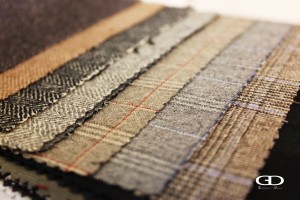 Wool is definitely the fabric with the best, common-sense, cold-weather reputation. Reducing wool to a cold-weather textile, however, falls way short of the versatility and usability of wool as an all-weather fabric, as you can also see in our warm-weather article. Wool, especially the coarser varieties with looser webbing or texture, is able to transport heat away from the body, keeping you cool in summer. Finer cloth, on the other hand, forms a formidable shield against the cold and keeps the warmth inside your sweater. Additionally, wool can absorb an incredible amount of moisture (e.g. sweat) and slowly release it to the outside.
Wool is definitely the fabric with the best, common-sense, cold-weather reputation. Reducing wool to a cold-weather textile, however, falls way short of the versatility and usability of wool as an all-weather fabric, as you can also see in our warm-weather article. Wool, especially the coarser varieties with looser webbing or texture, is able to transport heat away from the body, keeping you cool in summer. Finer cloth, on the other hand, forms a formidable shield against the cold and keeps the warmth inside your sweater. Additionally, wool can absorb an incredible amount of moisture (e.g. sweat) and slowly release it to the outside.
When shopping for a wool sweater or coat, we recommend looking for an item with fine materials to offer the shield mentioned above. If you want to inform yourself about some other general characteristics of wool that will help you finding the right item for you, we recommend checking out our Guide To Wool.
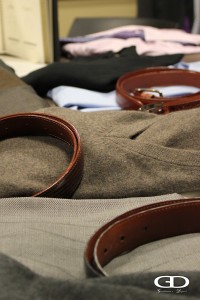 Cashmere
Cashmere
Cashmere is one of the most prominent fabric types and offers great material for winter warmers. Often mistaken for a wool, cashmere is actually a hair and, coming from the Cashmere goats, therefore much finer than common sheep‘s wool.
Oftentimes, products that are labeled Cashmere are actually a cashmere/cotton blend, and the range of quality and fineness can be significant. According to United States’ law, products labeled Cashmere need to satisfy certain standards in regard of thickness of fibers, averaging no higher than 19 microns. That equates to 0.00074803in or 0.019mm for our metric readers. Quite thin, we’d say…
Tweed
For me, Tweed is the by far the preferred option among traditional cold-weather fabrics. Tweed is mostly associated with the rough climate of certain regions (Northern England, Scotland, Ireland) or gentlemanly outdoor activities. Originally a working man’s cloth, English noblemen brought the fabric back from their hunting trips up North and had their London tailors convert them into something alike of what we now know as tweed jackets.
- How Tweed became Popular
 Prince Consort Albert, Queen Victoria’s husband, bought the Scottish estate of Balmoral in 1848 from the financially strapped Farguharsons of Inverey. While English Gentlemen did not have the history or rights of their own tartans as estate patterns, tweed fabrics offered a welcomed alternative. This development helped tweed to become one of the most fashionable and reputable types of fabrics, inextricably interwoven (pun intended) with the England’s upper leisure class and still maintaining its practicability and functionality as a cold-weather solution.
Prince Consort Albert, Queen Victoria’s husband, bought the Scottish estate of Balmoral in 1848 from the financially strapped Farguharsons of Inverey. While English Gentlemen did not have the history or rights of their own tartans as estate patterns, tweed fabrics offered a welcomed alternative. This development helped tweed to become one of the most fashionable and reputable types of fabrics, inextricably interwoven (pun intended) with the England’s upper leisure class and still maintaining its practicability and functionality as a cold-weather solution.
- Different Tweeds: Sheep and Regions
- A sophisticated purveyor of tweed will offer a variety of fabrics for buyers to choose from. Some tweed fabrics are named after the sheep the wool is harvested from. One example is the Cheviot Tweed fabric from the sheep of the Cheviot Hills in Northumberland. Rather heavy, stiff, and rough, it is considered one of the best choices for durable and firm country wear. Shetland Tweet, on the other hand, provides exceptionally fine wool. Fabrics from the Shetland Islands are the go-to wool for delicate and soft products, the embodiment of the high-end casual tweed jacket.
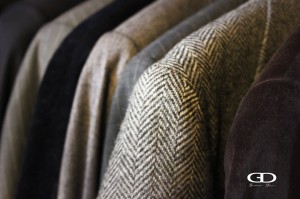 Other tweed fabrics are named after the region of origin. A popular example is the Saxony Tweed. Its history dates back to the late 18th century, when Spanish King Carlos III. sent a herd of Merino sheep to Saxony. Within a few decades, millions of sheep populated Saxony, providing some of the best and finest wool for tweed fabrics. Today, the Saxony Tweed is considered the prime option for formal wool jackets and suits, not only for casual, but also for business formal attire.
Other tweed fabrics are named after the region of origin. A popular example is the Saxony Tweed. Its history dates back to the late 18th century, when Spanish King Carlos III. sent a herd of Merino sheep to Saxony. Within a few decades, millions of sheep populated Saxony, providing some of the best and finest wool for tweed fabrics. Today, the Saxony Tweed is considered the prime option for formal wool jackets and suits, not only for casual, but also for business formal attire.
- How to wear tweed
- Tweed jackets are casual items and best suited for weekends or cold-weather activities such as bird hunting, casual bike rides, family outings or picnics, or a tailgate in fall. As a rule of thumb, you can wear a tweed jacket as an alternative to a jacket or light overcoat.
- The higher the weight, the thicker the fabric will be. If you are looking for a tweed jacket for hiking or long walks, look out for a jacket in the 300-400 grams range. Also, if you are heading to a party on a fall evening: a jacket made of fabrics north of 750 grams will likely be too warm to be worn inside and your best option will probably be a lighter version.
- Combine your tweed jacket with other earthy colors and avoid white items or any type of pastel. Tweed jackets are an invitation to be playful with green, brown, and dark blue tones of colors. Even reds can be a great compliment to your tweed jacket.
Flannel
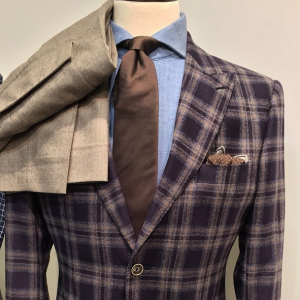 Flannel has various origins. It can be made of wool as well as of cotton or synthetic fibers. As a rule of thumb, we would not recommend synthetic fiber, unless we are talking functional underwear for sporting purposes or extreme survival trips to K2 (Everest is quite touristy these days…). Synthetic fibers may have shorter drying time than other fabrics, but if the cold winds catch you before it’s completely dry, you may be chilly… But that’s a tangent.
Flannel has various origins. It can be made of wool as well as of cotton or synthetic fibers. As a rule of thumb, we would not recommend synthetic fiber, unless we are talking functional underwear for sporting purposes or extreme survival trips to K2 (Everest is quite touristy these days…). Synthetic fibers may have shorter drying time than other fabrics, but if the cold winds catch you before it’s completely dry, you may be chilly… But that’s a tangent.
Cotton Flannel is produced through a mechanical process called carding, in which the fibers are passed between differentially moving surfaces with card clothing. This breaks up clumps of fibers and aligns them. Flannel is usually brushed to achieve its signature softness.
Flannel is extremely soft and offers a great shield against the cold. Flannel has established a reputation as the go-to fabric for sleepwear and bedding. It captures most of the warmth, but will not allow a lot of circulation. For bonfire night with a nice cup of Gluhwein, Flannel remains a staple cold-weather option. If you are an active citizen out-and-about, Flannel may not be the first choice.

